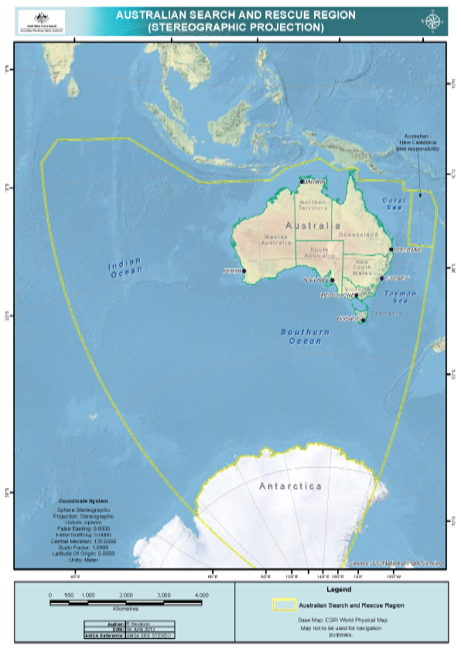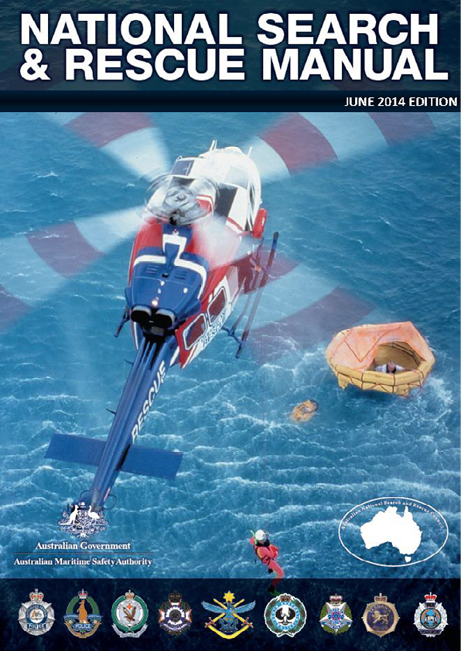Search and rescue in Australia
Senior Sergeant Jim Whitehead
Senior Sergeant Jim Whitehead, Queensland State Search and Rescue, explains the work of the organisation.
Article
The search and rescue system in Australia has returned an average of 2000 people per year1 to their families who might have otherwise perished on the seas, in the mountains, or in the deserts. This represents a saving to the Australian economy of about $10 billion annually in the earning and spending capacity of these people (COBP 2012). This article briefly outlines the story behind the current search and rescue system used in Australia and identifies the authorities responsible for both maintaining the system and using it on a daily basis throughout the country.

Australian search and rescue region. Image: www.amsa.gov.au
Search and rescue (SAR) is not normally associated with disaster or emergency management although they are similar bedfellows. The most obvious difference is the scale of events. Search and rescue normally involves a small number of missing people whereas an emergency or disaster can affect a community or a nation. Another less obvious difference is that the SAR system is used ‘in anger’ every day of the year with an average of five incidents occurring daily (National SAR Council Report 2013).
Search and rescue is the search for and provision of life saving assistance to people in distress and imminent danger of loss of life (National Search & Rescue Manual 20142).
Australian SAR arrangements provide a specialist search and rescue capability in conjunction with government, quasi-government and volunteer organisations. The current system covers locations as varied as the outback deserts, remote marine areas, and urban situations. In a country as vast and diverse as Australia it is not surprising that each SAR incident will be different from the previous.
Search and rescue does not generally extend to a missing person’s dog, cat or other pets. It also does not include the salvage or saving of property unless the act of lifesaving is indivisible from it. An example may be a rescue of people from a disabled vessel that may have rolled in dangerous seas but is still afloat. It may be safer to tow the entire vessel with crew to safety than attempt a vessel-to-vessel transfer in poor sea conditions.
The International Civil Aviation Organization (ICAO)3 was established in 1947 and implemented as a result of the Convention on International Civil Aviation of 1944. The SAR component of this organisation is the Chicago Convention, of which Australia is a Council Member State and one of the original signatories. Australia is considered a State of Chief Importance with respect to this convention.
Another specialised autonomous organisation is the International Maritime Organization (IMO)4 that was established in 1949. The SAR component is the International Convention for the Saving of Life at Sea (SOLAS) 1974, of which Australia was, again, an original signatory. The third convention is the International Convention on Maritime Search and Rescue 1979 covering the eastern Indian and western Pacific oceans. Both the ICAO and IMO work closely with other organisations to provide leadership for search and rescue globally.

The Manual is published by the Australian Maritime Safety Authority on behalf of the Australian National Search and Rescue Council.
Over the previous two centuries each Australian state and territory has developed their own SAR practices. Much of this has occurred on an ad hoc basis with whatever resources were available at the time. After the signing of the mentioned conventions there was a gradual movement in SAR towards unification that led to the 1976 formation of a national conference to ensure consistency in procedures across the Australian search and rescue region. In 1999 this conference officially gained the title of the National Search and Rescue Council and was given the role of formulating, discussing and ratifying national search and rescue policies. The Council’s profile was boosted by the 2004 Intergovernmental Agreement on National Search and Rescue Response Arrangement (IGA) that was signed by the Australian Government Ministers for transport and justice and the State/Territory Ministers for Police. This agreement was updated and re-signed in 2012 (National SAR Manual 2014). As a result of these agreements the Council provides management and co-ordination leadership on a national level for SAR policy and co-operative arrangements between the various SAR authorities. The Council also maintains the National SAR manuals on behalf of the nation.
The SAR authorities that were initially recognised by the Council were the:
- Maritime Rescue Coordination Centre
- Air Services Rescue Coordination Centres (Brisbane and Melbourne)
- Australian Army
- Royal Australian Navy
- Royal Australian Air Force
- State/Territory Police services
In 1997 the Maritime Rescue Coordination Centre merged with the two Air Services Rescue Coordination Centres to form Australian Search and Rescue (AusSAR), a part of the Australian Maritime Safety Authority. AusSAR has now been changed to the more formal Joint Rescue Coordination Centre (JRCC). In a similar move the three arms of the defence force are now co-ordinated from a central location known as HQJOC (Headquarters, Joint Operations Centre). Thus, only three SAR authorities are recognised today.
The following are the individual responsibilities of each of the three authorities:
- JRCC: International civil aircraft, manned space vehicles and aircraft on the Civil Aviation Safety Authority (CASA) and Recreational Aviation Australia (RA-Aus) Registers, unidentified beacons and persons on or from vessels at sea with Police.
- Australian Defence Force: Australian Defence Force and foreign military personnel, aircraft, ships, submarines and vehicles.
- State/Territory Police: Persons on or from vessels at sea with the JRCC, people and vehicles on land, people and vessels on inland waterways, non-military vessels within the limits of the ports of the relevant state/territory, and aircraft not included in the CASA and RA-Aus registers including ultra lights, hang gliders and para-gliders. Police also provide assistance to the JRCC with marine and land assets and co-ordination as required.
On the surface it appears that the division of responsibility is cut and dried, but over recent years there has been a slow movement towards having the best placed authority initially co-ordinating the incident until the actual responsible authority can take over. Having the closest responder attend an incident makes for a faster response and a better recovery rate.
The original National SAR Manual (NatSARM) was developed in the 1980s based on the International Aeronautical and Maritime Search and Rescue Manual. This manual is a collaboration between the IMO and ICAO and deals with aviation and marine SAR as the name suggests. This is regarded as world’s best practice and the manual is used by most countries for SAR purposes. The NatSARM has undergone a number of rewrites and had been amended numerous times until the 2009 Inquest into the sinking of the Malu Sara in the Torres Straits. This initiated a review and updating of its contents (Inquest findings into sinking of ‘Malu Sara’ 2009).
While aerial and marine search and rescue are covered extensively in the IAMSAR and NatSARM manuals, land search and rescue was included in a small but comprehensively broad publication titled Land Search Operations issued by Emergency Management Australia (EMA) in 1990. From the inception land SAR was primarily the responsibility of the State/Territory Police, as had been the case historically throughout Australia’s past.
In 2001 moves were made to standardise land SAR within Australia, followed in 2003 by the forming of a working group to write a national land manual for SAR. In 2007 the aging Land Search Operations Manual was ceded from EMA to the Council. In 2008 the National Land Search Operations Manual was written and adopted by the Council, becoming the standard for all land SAR operations within Australia from 2009.
While the SAR authorities are very capable, they alone cannot undertake search and rescue to the high level at which it is currently achieved. There is a vast number of government, quasi-government and volunteer organisations that contribute man hours and resources to SAR operations nationwide. These include:
- State Emergency Services
- State Marine Volunteer Rescue Groups such as the Australian Volunteer Coast Guard and Volunteer Marine Rescue
- Surf Life Saving Australia
- State and community helicopter providers
- Fire and rescue services
- Ambulance services
- Bush walking clubs
- Bureau of Meteorology
- Air Services Australia
- Australian Maritime Safety Authority
- Australian Communications and Media Authority
Access to resources is very much dependent on where in Australia the search and rescue incident is and where it is being co-ordinated from. Resources range from dedicated SAR aircraft, community helicopters, volunteer personnel and police.
The last important component of the Australian SAR system is the beacon detection capability. The most common are the Electronic Position Indicating Radio Beacon (EPIRB) used mainly at sea, the Emergency Locator Transmitters (ELT), which are normally fitted to aircraft, and Personal Locator Beacons (PLB) commonly carried by bushwalkers and four wheel driver owners. Regardless of the type of beacon they should all be registered with the JRCC and transmit on 406MHz. The 406MHz system is digitally based. Each beacon has an identification code that can identify the person, vessel or vehicle in distress. Once activated the signal is received by a number of low orbiting and geostationary satellites that relay it to a ground station and onto a RCC for action to be taken. If everything is aligned - beacon, satellite, ground station, SAR asset- then rescue can be as quick as 30 minutes but, in more remote parts of the country, it can take longer to get an asset on scene that has a rescue capability.
Australia has one of the best search and rescue systems in the world and it is only so because of the co-operation between all levels of SAR authorities. This work is underpinned by the selfless actions of volunteers in search and rescue organisations who search for and rescue strangers in all types of weather conditions.
References
Barnes M 2009, Findings from the Inquest into the sinking of the ‘Malu Sara’, Queensland Government.
Commonwealth Office of Best Practice (COBP) 2012, Guidance on the value of a statistical life. At: www.finance.gov.au.
International Civil Aviation Organisation 2013, International Aeronautical and Maritime Search and Rescue Manual, ch 1, London.
International Maritime Organisation 2013, International Aeronautical and Maritime Search and Rescue Manual, ch 1, London.
National Search and Rescue Council 2014, Report on the 37th National SAR Council Meeting, Hobart 2013, Canberra.
National Search and Rescue Council 2014, National Land Search Operations Manual, ch 1, Canberra.
National Search and Rescue Council 2014, National Search and Rescue Manual, ch 1, Canberra.
About the author
Senior Sergeant Jim Whitehead has been a policeman for 32 years and is the Queensland State Search and Rescue Coordinator & Training Officer. He has several Diploma and Advanced Diplomas of SAR Coordination and Management, a Bachelor of Social Science (Emergency Management), and a Master of Emergency Management. He has provided SAR instruction Queensland Police and volunteers, National Police SAR Manager’s Course, Royal Solomon Island Police, The Solomon Island Marine Rescue Coordination Centre, and the Australian Federal Police in Canberra, Christmas Island, Cocos Island and Norfolk Island.
Footnotes
1 AMSA Annual Report, Nat SAR Council State reports.
2 National Search & Rescue Manual 2014. At: http://natsar.amsa.gov.au/natsar-manual.asp.
3 ICAO website. At: www.icao.int/Pages/default.aspx.
4 IMO website: At: www.imo.org/Pages/home.aspx.


